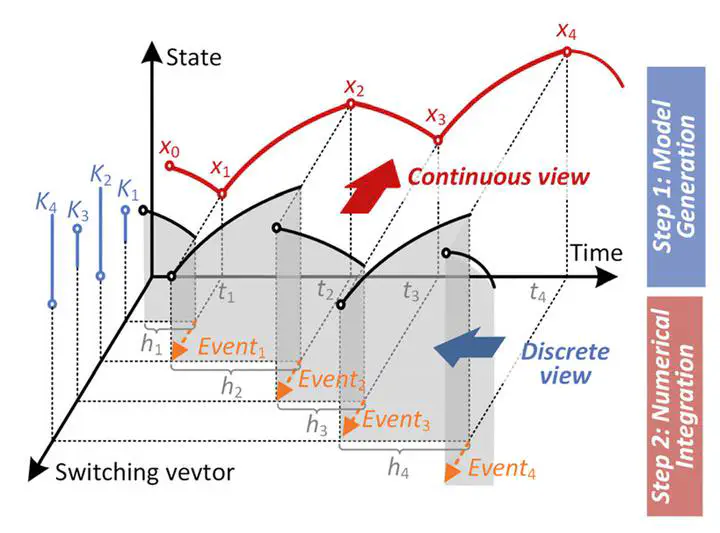Hybrid Dynamical System Modeling and Inference via Machine Learning

Overview
This project tackles the core difficulty of hybrid dynamical systems in power electronics: continuous ODE evolution punctuated by discrete switching events. We design models that (i) explicitly recognize event/mode structure, (ii) embed physics to reduce data burden and preserve interpretability, and (iii) run fast enough at the edge to support control. The result is a practical stack for modeling, inference, and control that remains stable under mode transitions and robust in Sim-to-Real deployment.
Just Ask for questions!
Explore our research with an AI assistant powered by the latest Gemini models and reliable sources to enhance your understanding and analysis.
Why This Research
- Hybrid dynamics are hard to learn. Standard discrete networks conflate sampling with dynamics and struggle with irregular mode durations.
- Sim-to-Real is brittle. Pure physics breaks under parameter drift; pure black-box needs huge data and often fails at mode boundaries.
- Edge devices are resource-constrained. Real-time requirements (sub-µs) and tight memory make classic high-order solvers impractical.
- Goal. Build event-aware, physics-consistent, edge-deployable models that keep continuous-time fidelity, cross mode transitions cleanly, and meet hard latency budgets.
New Measures
- Event-Automata Learning (EA). Decode control/PWM into mode sequences and event times, then learn per-mode dynamics; avoids sampling delay and reduces learning interference across modes.
- Physics-Embedded Neural ODEs (PENODE). Parameterize the continuous-time vector field as f(x,u)=f_phy(x,u;θ_phy)+f_NN(x;θ_NN). Physics supplies a stable backbone; the NN learns residuals only—improving data efficiency, interpretability, and generalization.
- Neural Substitute Solver (NSS). Replace two bottlenecks in numerical solvers with lightweight NNs: (1) event-triggered model updates (matrix ops) and (2) higher-order truncation terms of the integrator—turning sequential steps into parallel forward passes suitable for FPGA/MPSoC.
- Unified training with adjoint/backprop. Jointly optimize physical parameters and NN weights end-to-end; supports white-, gray-, and black-box regimes with a single pipeline.
- Cloud→Edge toolchain. Quantization-aware training, operator fusion, and HLS-based accelerators map PENODE/NSS to FPGAs/MPSoCs with deterministic timing; EA provides event-driven scheduling at inference.
- Data program for Sim-to-Real. Curate mixed simulation + hardware traces across modes and operating ranges; use EA to segment/align trajectories, then fine-tune to the target plant with small data.
Impact
- Learning efficiency. Event-aware decomposition reduces model size and accelerates convergence compared with single-mode discrete nets; residual learning lowers data demand.
- Sim-to-Real reliability. Physics-anchored representations maintain accuracy under parameter drift and unseen conditions; unified training avoids two-stage inconsistencies.
- Real-time edge inference. NSS and compact PENODE kernels deliver consistent per-step latency with low resource use—suitable for sub-µs budgets.
- Control integration. Continuous-time states/derivatives and clean mode boundaries feed MPC/optimal control without ad-hoc filters; improved transients and stability margins.
- Maintainability & insight. Physical parameters remain visible and tunable; residual terms highlight unmodeled effects for diagnostics.